I haven't provided detailed commentary on the US labour market for a while now. To…
Australian labour market – stronger employment growth but still uncertain
The Australian Bureau of Statistics released the latest – Labour Force, Australia, June 2018 – today which show that the Australian labour market gained some strength after several months of poor results. Overall employment growth was stronger with a robust increase in full-time employment, although the overall increase in monthly hours worked was modest. Unemployment fell marginally with the unemployment rate steady at 5.4 per cent. However, participation rose by 0.2 per cent and employment growth was strong enough to absorb both the underlying population growth and the new entrants into the labour force. The teenage labour market delivered mixed results – with overall employment rising disproportionately but full-time employment declining. A further grey cloud came with the rise in underemployment by 35.1 thousand to 8.6 per cent. The broad labour underutilisation rate rose to 13.73 per cent. Overall, my assessment is that the Australian labour market remains in an uncertain state and is still a considerable distance from full employment.
The summary ABS Labour Force (seasonally adjusted) estimates for June 2018 are:
- Employment increased 50,900 (0.4 per cent) – full-time employment increased 41,200 and part-time employment increased 9,700.
- Unemployment decreased 1,100 to 714,100.
- The official unemployment rate remained steady at 5.4 per cent.
- The participation rate increased by 0.2 points to 65.7 per cent, which is still below its previous peak (December 2010) of 65.8 per cent.
- Aggregate monthly hours worked increased 10.7 million hours (0.6 per cent).
- The monthly estimates for June 2018 show that underemployment rose by 35.1 thousand and was estimated to be 8.6 per cent of the labour force. The total labour underutilisation rate (unemployment plus underemployment) was rose to 13.73 per cent. There were 1,137.8 thousand persons underemployed and a total of 1,826 thousand workers either unemployed or underemployed.
Employment growth – much stronger in June
Employment growth was stronger in July after a several months of mediocrity.
Employment rose by 50,900 with full-time employment increasing by 41,200 and part-time employment increasing 9,700.
The following graph shows the month by month growth in full-time (blue columns), part-time (grey columns) and total employment (green line) for the 24 months to June 2018 using seasonally adjusted data.
It gives you a good impression of just how flat employment growth had been leading into 2017.
Overall: today’s result signals a stronger labour market.
Whether that is the start of a stronger trend will be revealed in the next few months.
The following table provides an accounting summary of the labour market performance over the last six months. The monthly data is highly variable so this Table provides a longer view which allows for a better assessment of the trends.
Overall there have been 116.8 thousand jobs (net) added in Australia over the last six months while the labour force has increased by 99.4 thousand. The result has been that unemployment has fallen by 17.4 thousand.
These aggregate changes signify a modest labour market performance at best.
Given the variation in the labour force estimates, it is sometimes useful to examine the Employment-to-Population ratio (%) because the underlying population estimates (denominator) are less cyclical and subject to variation than the labour force estimates. This is an alternative measure of the robustness of activity to the unemployment rate, which is sensitive to those labour force swings.
The following graph shows the Employment-to-Population ratio, since February 2008 (the low-point unemployment rate of the last cycle).
It dived with the onset of the GFC, recovered under the boost provided by the fiscal stimulus packages but then went backwards again as the last Federal government imposed fiscal austerity in a hare-brained attempt at achieving a fiscal surplus.
The ratio began rising in December 2014 which suggested to some that the labour market had bottomed out and would improve slowly as long as there are no major policy contractions or cuts in private capital formation.
The series turned again as overall economic activity weakened.
The ratio rose by 0.1 points in June 2018 to 62.1 per cent and remains well below pre-GFC peak in April 2008 of 62.9 per cent.
To put the current monthly performance into perspective, the following graph shows the average monthly employment change for the calendar years from 2005 to 2018 (the 2018 result is up to June only).
It is clear that after some lean years, 2017 was a much stronger year if total employment is the indicator.
It is also clear that the labour market has weakened considerably in the first six months of 2018.
To provide a longer perspective, the following graphs shows the average monthly changes in Total employment (upper panel), and Full-time and Part-time employment (lower panel) in thousands since 1978 (when the current dataset began).
The 2018 average is up to June only so is not definitive.
The interesting result is that during recessions or slow-downs, it is full-time employment that takes the bulk of the adjustment. Even when full-time employment growth is negative, part-time employment usually continues to grow.
Teenage labour market – mixed outcomes in June
Total teenage employment rose by 13.5 thousand jobs in June but full-time teenage employment fell by 0.3 thousand, while part-time employment rose by 13.8 thousand.
The following graph shows the distribution of net employment creation in the last month by full-time/part-time status and age/gender category (15-19 year olds and the rest)
Over the last 12 months, teenagers have gained 60.4 thousand (net) jobs overall while the rest of the labour force have gained 265.1 thousand net jobs.
Teenagers have gained around 17.8 per cent of the total net employment growth over the last 12 months but only represent around 6.2 per cent of the total labour force. So they are doing relatively better in that sense.
The following graph shows the change in aggregates over the last 12 months.
In terms of the current cycle, which began after the last low-point unemployment rate month (February 2008), the following results are relevant:
1. Since February 2008, there have been 1,926 thousand (net) jobs added to the Australian economy but teenagers have lost a 43.9 thousand over the same period. That loss has fallen significantly in the first six months of 2018.
2. Since February 2008, teenagers have lost 102.4 thousand full-time jobs (net).
3. Even in the traditionally, concentrated teenage segment – part-time employment, teenagers have gained only 58.5 thousand jobs (net) even though 1001.9 thousand part-time jobs have been added overall.
To put the teenage employment situation in a scale context (relative to their size in the population) the following graph shows the Employment-Population ratios for males, females and total 15-19 year olds since February 2008.
You can interpret this graph as depicting the loss of employment relative to the underlying population of each cohort. We would expect (at least) that this ratio should be constant if not rising somewhat (depending on school participation rates).
The absolute loss of jobs reported above has impacted more on males than females.
The male ratio has fallen by 8.2 percentage points since February 2008, the female ratio has fallen by 1 percentage point and the overall teenage employment-population ratio has fallen by 4.7 percentage points.
The rise in teenage part-time employment in recent months has meant that the teenage employment-population ratios have risen consistently over the period.
The other statistic relating to the teenage labour market that is worth highlighting is the decline in the participation rate since the beginning of 2008 when it peaked in February at 61.4 per cent.
In June 2018, the participation rate was 55.7 per cent (up by 0.9 percentage points). The rising participation rate reflected the stronger employment growth for teenagers.
However, the difference between the 2008 level, amounts to an additional 75.9 thousand teenagers who have dropped out of the labour force as a result of the weak conditions since the crisis.
If we added them back into the labour force the teenage unemployment rate would be 21.8 per cent rather than the official estimate for June 2018 of 14.7 per cent.
Some may have decided to return to full-time education and abandoned their plans to work. But the data suggests the official unemployment rate is significantly understating the actual situation that teenagers face in the Australian labour market.
Overall, the performance of the teenage labour market leaves a lot to be desired. The decline in full-time employment for teenagers was particularly worrying.
This situation doesn’t rate much priority in the policy debate, which is surprising given that this is our future workforce in an ageing population. Future productivity growth will determine whether the ageing population enjoys a higher standard of living than now or goes backwards.
I continue to recommend that the Australian government immediately announce a major public sector job creation program aimed at employing all the unemployed 15-19 year olds, who are not in full-time education or a credible apprenticeship program.
Unemployment decreased 1,100 to 714,100
The official unemployment rate remained steady at 5.4 per cent in June 2018 because employment growth was able to match the underlying population growth and the rising participation rate.
The following graph shows the national unemployment rate from February 1978 to June 2018. The longer time-series helps frame some perspective to what is happening at present.
After falling steadily as the fiscal stimulus pushed growth along, the unemployment rate slowly trended up for some months.
It is still 0.5 points above the level it fell to as a result of the fiscal stimulus and 1.4 points above the level reached before the GFC began.
Conclusion: there is still considerable slack in the labour market that should be absorbed with fiscal stimulus.
Broad labour underutilisation rises to 13.7 per cent
The results based on the Monthly data for June 2018 are:
1. Underemployment rose by 35.1 thousand and was estimated to be 8.6 per cent of the labour force (up from 8.3 per cent).
2. The total labour underutilisation rate (unemployment plus underemployment) was steady at 13.73 per cent (up from 13.6 per cent).
3. There were 1,137.8 thousand persons underemployed and a total of 1,826 thousand workers either unemployed or underemployed.
So even with continued employment growth, the Australian labour market has nearly 1.9 million workers available for work who cannot find sufficient hours.
In terms of the quarterly data, the following graph plots the seasonally-adjusted underemployment rate in Australia since February 1978 to the May-quarter 2018 (blue line) and the broad underutilisation rate over the same period (green line).
The difference between the two lines is the unemployment rate.
You can see the three cyclical peaks corresponding to the 1982, 1991 recessions and the more recent downturn.
The other difference between now and the two earlier cycles is that the recovery triggered by the fiscal stimulus in 2008-09 did not persist and as soon as the ‘fiscal surplus’ fetish kicked in in 2012, things went backwards very quickly.
The two earlier peaks were sharp but steadily declined. The last peak fell away on the back of the stimulus but turned again when the stimulus was withdrawn.
If hidden unemployment (given the depressed participation rate) is added to the broad ABS figure the best-case (conservative) scenario would see a underutilisation rate well above 15 per cent at present. Please read my blog post – Australian labour underutilisation rate is at least 13.4 per cent – for more discussion on this point.
The next quarterly update will be for the August-quarter 2018 and will be published published in the September 2018 Labour Force release. In between those releases, the monthly estimates will guide our thinking.
Hours worked – increased by 10.7 million hours (0.62 per cent).
The following graph shows the monthly growth (in per cent) over the last 24 months.
The dark linear line is a simple regression trend of the monthly change – which depicts a fairly flat trend – distorted somewhat by the outlier in May 2017 (the trend would have been more sharply downward without that positive spike).
You can see the pattern of the change in working hours is also portrayed in the employment graph – zig-zagging across the zero growth line although less so in 2017.
Conclusion
My standard monthly warning: we always have to be careful interpreting month to month movements given the way the Labour Force Survey is constructed and implemented.
Today’s figures show that the Australian labour market gained some strength after several months of poor results.
Overall employment growth was stronger with a robust increase in full-time employment, although the overall increase in monthly hours worked was modest.
Unemployment fell marginally with the unemployment rate steady at 5.4 per cent.
However, participation rose by 0.2 per cent and employment growth was strong enough to absorb both the underlying population growth and the new entrants into the labour force.
The teenage labour market delivered mixed results – with overall employment rising disproportionately but full-time employment declining.
A further grey cloud came with the rise in underemployment by 35.1 thousand to 8.6 per cent. The broad labour underutilisation rate rose to 13.73 per cent.
Taken together, my overall assessment is:
1. The labour market remains in an uncertain state.
2. It remains a considerable distance from full employment.
That is enough for today!
(c) Copyright 2018 William Mitchell. All Rights Reserved.
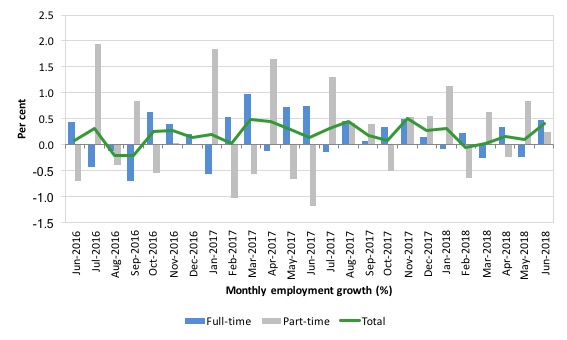
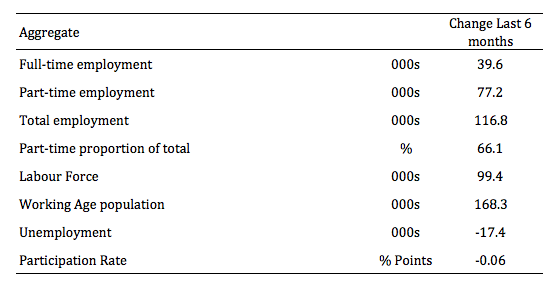

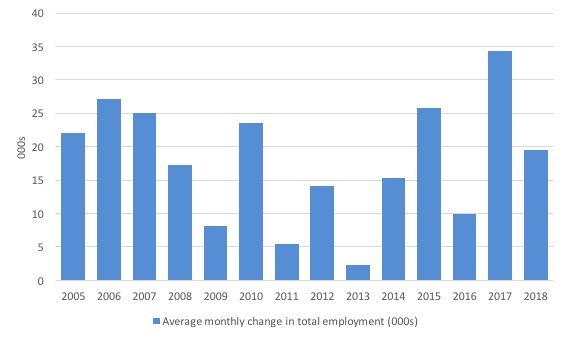
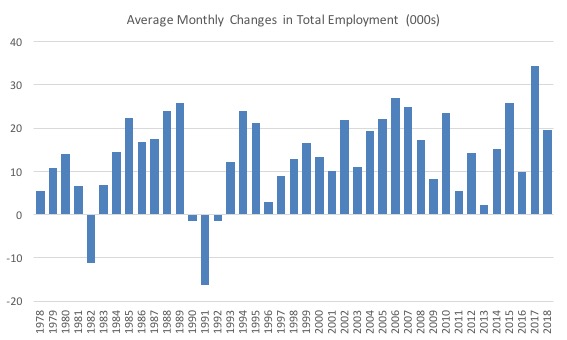
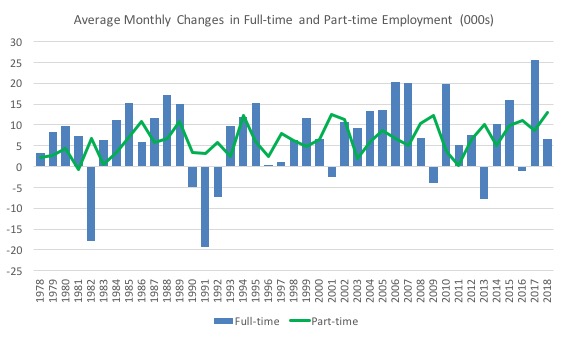
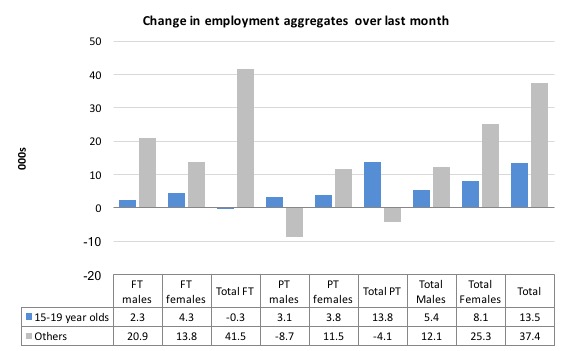
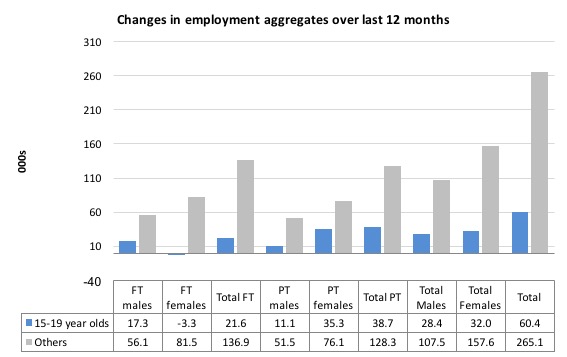
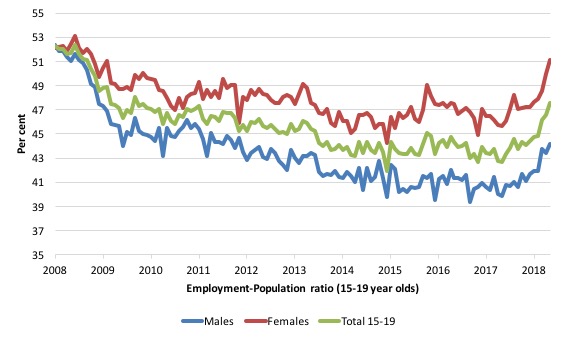

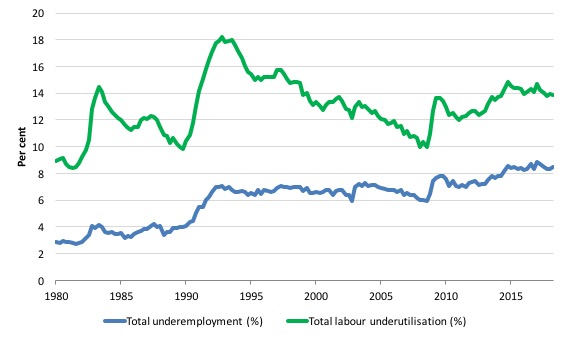
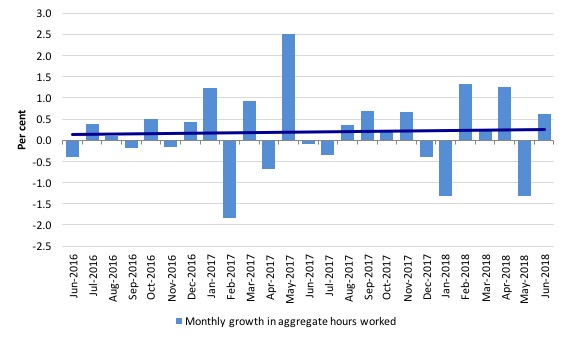
With tongue firmly in cheek one must ask that the UK post-Brexit will give a huge boost to Australian economic futures.
Hello,
Interesting that unemployment is still managing to fall in the face of what is now a negative private sector sectoral balance.
It can only be a burst of private sector credit creation that is driving it. Households taking on debt to fund consumption.
I have found that just about every western English speaking economy has a negative private sector balance. The only exception is America. It is as though all follow the same neoliberal austerity bias playbook and are lining up for a recession brought about by a a collapse in aggregate demand once peak private debt is reached.
The common bias towards raising interest rates on this private debt accelerates the process.
One interesting new phenomenon is that world central banks have reached peak support and their bank balances are rolling over and reducing. This takes away asset price support for the highly leveraged capital structure and apart from Japan has not happened before.
Again another policy bias adopted as a neoliberal consensus. Global liquidity drops away precipitously after August 2018, same thing happened in 2016 on a smaller scale. In 2016 markets sagged and unemployment rose. The next one could be deeper a see a reversal in the plucky Australian employment trend.